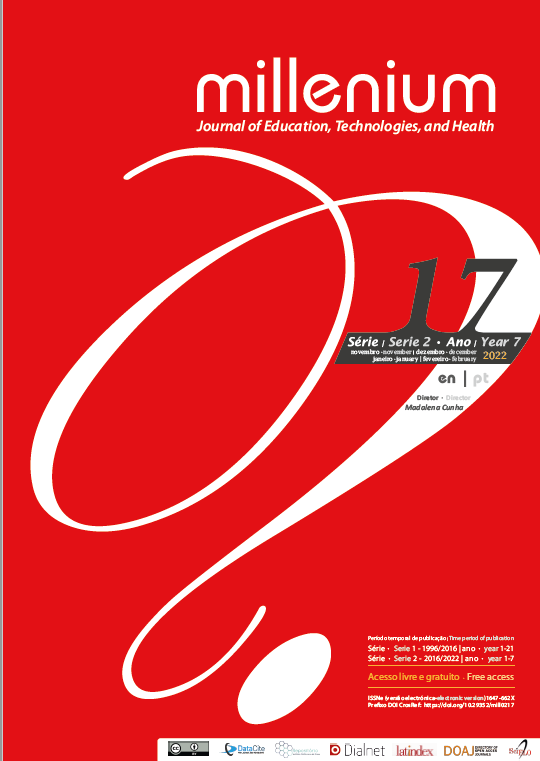Perspetiva dos enfermeiros especialistas sobre os cuidados atraumáticos em pediatria
DOI:
https://doi.org/10.29352/mill0217.24102Palavras-chave:
cuidados atraumáticos, enfermagem pediátrica, cuidados de enfermagem, enfermeiras pediátricasResumo
Introdução: A hospitalização consiste numa transição saúde-doença potenciadora de efeitos negativos na criança e família, como alterações na dinâmica familiar, retrocessos no desenvolvimento, ansiedade e medo. A prestação de cuidados atraumáticos deve ser uma premissa base em Pediatria, para minimizar estes efeitos.
Objetivo: Identificar os conhecimentos dos Enfermeiros Especialistas acerca dos cuidados atraumáticos em contexto hospitalar pediátrico; identificar as intervenções e estratégias promotoras de cuidados atraumáticos implementadas pelos Enfermeiros Especialistas; identificar os obstáculos à implementação de cuidados atraumáticos na prática referidas pelos Enfermeiros Especialistas.
Métodos: Estudo descritivo, exploratório de natureza qualitativa, recorrendo a focus group, com amostra por conveniência de oito Enfermeiros Especialistas em Saúde Infantil e Pediátrica, e analisando os dados segundo a técnica de análise de conteúdo de Bardin.
Resultados: Da análise dos dados relativos às quatro dimensões pré-estabelecidas para o estudo, emergiram 12 categorias.
Conclusão: Os Enfermeiros Especialistas reconhecem a importância dos cuidados atraumáticos em Pediatria, implementando-os intrinsecamente na prática. Identificam como principais obstáculos à sua implementação a falta de tempo e de recursos. Reconhecem a necessidade da gestão de recursos humanos e materiais, a importância da formação profissional na temática, e a necessidade da criação de intervenções protocoladas relacionadas com cuidados atraumáticos, de forma a promover a humanização da assistência.
Downloads
Referências
Barroso, M. C. da C. S. (2016). O uso do brinquedo terapêutico pelos acadêmicos de enfermagem no cuidado à criança hospitalizada. [Monografia, Escola de Enfermagem Aurora de Afonso Costa].
Çalişir, H., & Karataş, P. (2019). The Atraumatic Care Approach in Pediatric Nursing: Non-Pharmacological Applications in Reducing Pain, Stress, and Anxiety. Koç Üniversitesi Hemşirelikte Eğitim Ve Araştirma Dergisi, 16(3), 234-245. http://dx.doi.org/10.5222/HEAD.2019.234
Costa, D. T. L., Veríssimo, M. de L. Ó R., Toriyama, A. T. M., & Sigaud, C. H. de S. (2016). O brincar na assistência de enfermagem à criança - revisão integrativa. Revista da Sociedade Brasileira de Enfermeiros Pediatras, 16(1), 36-43. http://dx.doi.org/10.31508/1676-3793201600005
Ellis, J. A., Sharp, D., Newbook, K., & Cohen, J. (2004). Selling Comfort: A Survey of Interventions for Needle Procedures in a Pediatric Hospital. Pain Management Nursing, 5(4), 144-152. http://dx.doi.org/10.1016/j.pmn.2004.09.002
Freitas, B. H. B. M. de, & Voltani, S. dos S. A. A. (2016). Brinquedo terapêutico em serviço de urgência e emergência pediátrica: revisão integrativa de literatura. Cogitare Enfermagem, 21(1), 01-08. http://dx.doi.org/10.5380/ce.v21i4.40728
Hockenberry, M. J. & Wilson, D. (2014). Wong - Enfermagem da criança e do adolescente (9ºed). Lusociência.
Huff, L., Hamlin, A., Wolski, D., McClure, T., & Eliades, A. B. (2009). Atraumatic care: EMLA cream and application of heat to facilitate peripheral venous cannulation in children. Issues in Comprehensive Pediatric Nursing, 32, 65-76. http://dx.doi.org/10.1080/01460860902737418
Leite, T. M. C., Vergílio, M. S. T. G., & Silva, E. M. (2016). Processo de trabalho do enfermeiro pediatra: uma realidade a ser transformada. Rev. Rene, 18(1), 26-64. http://dx.doi.org/10.15253/2175-6783.2017000100005
Marques, E. P., Garcia, T. M. B., Anders, J. C., Luz, J. H. da, Rocha, P. K., & Souza, S. de (2016). Lúdico no cuidado à criança e ao adolescente com câncer: perspectivas da equipe de enfermagem. Escola Anna Nery, 20(3). http://dx.doi.org/10.5935/1414-8145.20160073
Mediani, H. S., Hendrawati, S., & Shidqi, N. (2019). The Knowledge and Attitude of Nurses in the Implementation of Atraumatic Care in Hospitalized Children in Indonesia. Journal of Nursing and Health Science, 8(1), 51-56. http://dx.doi.org/10.9790/1959-0801075156
Meleis, A. I., Sawyer, L. M., Im, E. O., Messiais, D. K. H., & Schumacher, K. (2000). Experiencing transitions: an emerging middle-range theory. Advances in nursing science, 23(1), 12-28. http://dx.doi.org/10.1097/00012272-200009000-00006
Ordem dos Enfermeiros (2013). Guia Orientador de Boa Prática – Estratégias não farmacológicas no controlo da dor na criança. Cadernos OE, Série 1, Número 6.
Orientação nº 022/2012 da Direção-Geral da Saúde (2012). Retrieved from: https://www.dgs.pt/directrizes-da-dgs/orientacoes-e-circulares-informativas/orientacao-n-0222012-de-18122012-png.aspx
Pereira, C. R., Lima, K. G. de J., Rodrigues, M. T. M., Durães, P. J. A., Neves, S. de J. O., Viana, T. M., Prado, P. F., & Souza, A. A. M. de (2018). A humanização da assistência de enfermagem à criança hospitalizada: uma revisão integrativa. Revista Intercâmbio, 19, 70-85. Retrieved from: http://www.intercambio.unimontes.br/index.php/intercambio/article/view/224/222
Perry, S., Hockenberry, J., Lowdermilk, D., Wilson, D., Keenan-Lindsay, L., & Sams, C. (2017). Maternal Child Nursing Care in Canada. 2nd ed. Elsevier.
Regulamento nº 422/2018 da Ordem dos Enfermeiros (2018). Diário da República: II série, nº133. Retrieved from: https://www.ordemenfermeiros.pt/media/8733/infantil.pdf
Urquiza, M. de A., & Marques, D. B. (2016). Análise de conteúdo em termos de Bardin aplicada à comunicação corporativa sob o signo de uma abordagem teórico-empírica. Entretextos, Londrina, 16(1), 115-144. http://dx.doi.org/10.5433/1519-5392.2016v16n1p115
Yin, T., Yang, L., Lee, T., Li, C., Hua, Y., & Liaw, J. (2015). Development of atraumatic heel-stick procedures by combined treatment with non-nutritive sucking, oral sucrose, and facilitated tucking: A randomised, controlled trial. International Journal of Nursing Studies, 52, 1288-1299. http://dx.doi.org/10.1016/j.ijnurstu.2015.04.012
Downloads
Publicado
Como Citar
Edição
Secção
Licença

Este trabalho encontra-se publicado com a Licença Internacional Creative Commons Atribuição 4.0.
Os autores que submetem propostas para esta revista concordam com os seguintes termos:
a) Os artigos são publicados segundo a licença Licença Creative Commons (CC BY 4.0), conformando regime open-access, sem qualquer custo para o autor ou para o leitor;
b) Os autores conservam os direitos de autor e concedem à revista o direito de primeira publicação, permitindo-se a partilha livre do trabalho, desde que seja corretamente atribuída a autoria e publicação inicial nesta revista.
c) Os autores têm autorização para assumir contratos adicionais separadamente, para distribuição não-exclusiva da versão do trabalho publicada nesta revista (ex.: publicar em repositório institucional ou como capítulo de livro), com reconhecimento de autoria e publicação inicial nesta revista.
d) Os autores têm permissão e são estimulados a publicar e distribuir o seu trabalho online (ex.: em repositórios institucionais ou na sua página pessoal) já que isso pode gerar alterações produtivas, bem como aumentar o impacto e a citação do trabalho publica
Documentos necessários à submissão
Template do artigo (formato editável)





